
Atlas F1 Technical Writer
The Spanish Grand Prix saw the debut of the much-awaited Ferrari F2003-GA, and although the rest of the teams continued with their old cars, there were some interesting new technical details. Atlas F1's Craig Scarborough examines the components that made up the weekend of the Spanish Grand Prix
It was a conventional race at a conventional circuit and in conventional weather, with only the opening lap incidents bringing out the safety car and ruining a few drivers' races. Nevertheless, the race weekend should prove to be a good barometer for the other European permanent circuits. As such, it was a surprise to see McLaren struggle so much in qualifying, although their race was effectively over on the first lap, so their race pace has yet to be disproved.
Renault in contrast were expected to go well but struggle for ultimate lap times due to lack of power, yet the car with its low top speed pushed the Ferraris all weekend. Williams were around the same position as witnessed in Imola - the best of the rest but no threat to the top two (or three, if Renault is now counted).
BAR and Toyota benefited from their familiarity of the circuit, with both teams showing well. Toyota, in particular, proving to be well up on pace, while BAR saw the drivers split by a discernable margin for the first time. Yet if the teams that have tested at Barcelona recently were able to show their potential, what does that tell us about the new rules? The lack of running over a race weekend clearly handicaps new drivers and less experienced teams, but quite how this is good for the show or the formula's longevity is questionable.
Tyres saw Bridgestone suffering Michelin-like fall off in pace after the first few laps - Bridgestone runners were questioning whether two stops would minimise time lost during this phase, but overall degradation after 13-15 laps put paid to that strategy, so scrubbed tyres fitted during race pitstops recovered some of the lost grip for the teams with the time to scrub the tyres in. Michelin did not suffer the early stint drop-off to the same extent and actually improved as the tread wore down until the compound had 'gone-off'.
F2003-GA Debut
Launched back in February at Fiorano, the F2003-GA is a new car but very much a development of the layout and philosophies from the recent history of Ferrari. Ross Brawn and the design team headed by Rory Byrne were not able to find a revolution in order to improve one of the statistically best Formula One cars; instead, improvements in the minutiae of the car had been aggregated for a step over the previous version.
Every detail on the car has been scrutinised, and many detail developments are visible around the car. Every aspect of the car's design has had its efficiency improved, from large systems such as the engine and gearbox to the installation of the rear suspension, radiators and brakes.
The F2003-GA can be summarised as an F2002 with a new lower, narrower engine mated to a much shorter faired-in gearbox, with the chassis lengthened to keep the wheelbase similar. This repositioning of the masses allowed the team to adopt a sculpted frontal aspect to the sidepods; the undercutting of the front of the sidepods leaves only the side impact protection and the ducting to the radiators wrapped in bodywork. This reduces the aerodynamic cross section and improves the flow of air along the sides of the chassis into the coke bottle shape.
Among the visible changes was a weight reduction program allowing the team to place huge amounts of ballast into the splitter under the chassis. The new car tested in this format mainly in Italy until this weekend, and many problems occurred during this testing phase - with suspension failures, engine failures and a cooling problem. It was the cooling problem that delayed the program, as both the engine design and aerodynamics may have needed to be changed.
The subsequent identification of the lack of cooling flow through the waisted sidepods lead to long shifts at the factory over the Easter break, and distinctive cooling "gills" appeared on the sidepods before its debut last weekend. This rush to prepare the revised aerodynamic cooling solution has lead to a slightly compromised F2003-GA, and a step away from the original aero philosophy.
In Spain, Ferrari was justifiably proud of their car, and Ross Brawn was drawing attention to the innovative brake duct arrangement by commenting on how much of a step forward they are. Overall, the team were incredibly open when working on the car in and around the pits, allowing photographers to get in and take clear images of the brakes, gearbox and engine installation. Updated from the car's launch and early testing spec were new brake ducts, cooling outlets, bargeboards and rear wing.
Rubens Barrichello commented that the braking was the biggest area of improvement on the new car, with part of this improvement stemming from the new brake duct arrangement fitted front and rear. In other words, Ferrari - who invented the enclosed brake duct - have taken it a step further.
The new setup retained the bucket-like duct on the inside of the disc. This duct acts to control the flow of air through the wheel, preventing heated air from the ventilated disc or high pressure on the outside of the wheel passing through the wheel and exiting through the inside face of the wheel upsetting the aerodynamics.
The new set up now features a donut shaped carbon fibre ring on the outside of the disc. Its function is not clear right now but it appears to act in two ways: firstly, to cool the outer side of the brake assembly, by air passing through into the donut duct and directed to cool the face of the disc and outer part of the brake calliper; and secondly, by directing the heated air from the disc out through the wheel more effectively, thereby creating a tighter passage between the wheel rim and duct, so that the faster moving air can be better forced out of the wheel.
One of the details added to the car is the way the fairing wrapped around the gearbox and is integrated with the heat shielding around the engine to smooth the flow from the radiators out of the sidepods. And, also seen on occasion on the F2002, the F2003-GA featured a revised triple plane rear wing with small notches cut out of the trailing edge of the flap and small lifts on the front edge of the flap, so as to reduce drag and trailing vortexes.
Team by Team
McLaren
With no changes visible on the car at either Imola or Spain, the MP4/17D has reached the end of its development. The team are pressing ahead with the new car, and the poorer showing at Imola was echoed in Spain. Being Championship leaders saw the drivers run first on Friday's first qualifying session (Q1), and the dusty track affected their times, as clean laps only saw the cars eighth and ninth quickest.
Another pre-qualifying engine scare saw David Coulthard go into Saturday's qualifying session (Q2) in the spare, and a conservative lap allied to a sluggish-looking car saw him put in a disappointing lap time. Kimi Raikkonen meanwhile went out and attacked the track but out-braked himself in the second sector, subsequently running across the gravel and aborting his lap.
In the race, Raikkonen started from the back row and had barely got moving when he rammed the back of Antonio Pizzonia's stalled Jaguar, while up at the front Coulthard had made progress through turn 1 only to come together with Renault's Jarno Trulli and spin into the gravel. He immediately pitted for tyres, but 17 laps later had another coming together with BAR's Jenson Button and had to retire, with his car stranded in the gravel.
Ferrari
Michael Schumacher again wore his revised Schuberth helmet with a filtered breath guard around his mouth and nose. The helmet also has raised moulded hard-points for the HANS device to strap to. Teammate Barrichello has also adopted this helmet since his discomfort with the HANS setup and his Arai helmet earlier in the season.
From first Friday practice the car performed almost faultlessly, aside from a water leak forcing Barrichello into the spare car for his Q1 lap. Schumacher was able to take a calm lap to post his provisional pole in this session.
For Q2, Barrichello ran first of the two drivers and set the faster speed trap time at over 325 km/h, his lap was fast but his third sector time was slower and left him second overall. Then, Schumacher clocked the speed trap at 322 km/h and his first time was three thousandths of a second slower than Barrichello, suggesting that perhaps Schumacher ran a little more wing than the Brazilian, because his following sector times pushed him again into pole position with a quarter of a second faster time than Barrichello.
At the start of the race, the Ferrari couldn't beat the Renaults off the line but managed to get through Turn 1 split by only one car and then circulated under the subsequent safety car. Despite the five laps of low fuel consumption the team ran a three stop strategy for both cars, in order to combat the Bridgestone tyres' late stint drop-off.
Schumacher struggled at the end of his stints and pitted for scrubbed tyres on Laps 19, 33 and 48. Barrichello ran one lap more in all his stints, suggesting he had slightly more fuel in for qualifying. The Ferraris ran very little wing all weekend and in the race were probably aided by slipstreaming, as Schumacher clocked the fastest speed of 331 km/h. The new car ran reliably through to a first and third placing.
Renault
Regardless of any power deficit, Renault were on the pace all weekend and lowly standings on the speed traps were countered by exceptional corner speed and traction. Q1 saw Fernando Alonso over-brake into Turn 1 and running a little wide, compromising his first sector time. Jarno Trulli meanwhile had an error-free lap to post the second fastest time of the session. In Q2, Alonso made no errors and posted third best time, with Trulli following up in fourth.
The softer Michelin tyres, which benefited Renault's qualifying performance, were not expected to cope with the heat of race day, but after the Renault launch control was able to beat the Ferraris, Alonso kept in touch with the World Champion in both speed and strategy (3 stops) throughout the race. Trulli, on the other hand, had no chance to put in such a performance, having retired on Lap 1 in an incident that left him stranded in the gravel. Amazingly, he posted Renault's first DNF this year.
Williams
Changes to the car are starting to suit Ralf Schumacher better, whereas Juan Pablo Montoya - initially complimentary of the car - is now berating its handling and grip. Schumacher was quickest on Friday's first session and in Q1 made an error with too much oversteer in Sector 1, pushing him out of the top ten. Montoya was struggling even more with the car, constantly having to correct the steering wheel and even changing settings via the steering during his lap, but was only fourteenth fastest.
Saturday morning saw Montoya spin off into the gravel, forcing him into the spare for Q2. A tidy lap put him back in the top ten, in ninth, while Schumacher went three tenths of a second better but only found himself two places up the grid.
For the race, Williams were one of the few to adopt a two-stop strategy. Schumacher came in early for a short opening stint on lap 17 and again on lap 41, while Juan pitted a lap later for each stop. Williams found the degradation from the Michelins to be quite bad and both drivers ran wide, enabling other drivers to catch up or pass them during the race.
Jordan
Q1 saw an error-free but slow lap from Giancarlo Fisichella, while Ralph Firman, despite running wide once, put in a good lap only two places down on his teammate. Firman's growing confidence and familiarity made his Q2 run even better, with a lap two positions quicker than Fisichella's.
The Jordans were running slow and their speed trap times of only 304 and 307 km/h in Q1 showed both the power deficit and need for downforce to make the car grip.
Fisichella's engine problems from Imola returned with two failures on Saturday and another in the race, on lap 44, after a disastrous pitstop on lap 22 when the fuel rig failed. Firman ran three to collect his first points of the season.
Sauber
Sauber arrived with new but unidentifiable development parts on the car, although the changes did not account for much; the car is still lacking speed despite its balance. Heinz Harald Frentzen improvised with some oversteer in the slower corners but qualified out of the top fifteen in Q1, and then broke into the top ten in Q2, with Nick Heidfeld trailing in fourteenth.
After the safety car was called out on Lap 1, Heidfeld pitted to top his fuel and get fresh tyres and again on laps 32 and 46. Frentzen made his first stop only to retire a few laps later, having trailed around the circuit for half a lap with suspension failure. Heidfeld ran to the end coming home in tenth.
BAR
Without the expected aerodynamic update in Spain, BAR had modified the car as Jacques Villeneuve had his head restraint built up with padding. Villeneuve was unhappy all weekend, bemoaning his car's unreliability and lack of pace, and his Q1 lap was slower than Jenson Button's by some margin.
Q2 was the same, where Villeneuve was running more fuel but unable to find a balance despite a tidy lap. Button's lap saw corner-entry understeer and oversteer on the exit, but pushed the car hard for a fifth spot on the grid.
In the race, Button pitted on lap 5 only to collide with Coulthard on lap 17 while going into Turn 1. Villeneuve, on the other hand, was already out of the race coming to an angry halt with smoke coming from both Villeneuve and the failed Honda engine.
Toyota
Strong Q1 runs - with 315 km/h top speeds, only bettered by Ferrari - saw the drivers slot into fourth and sixth, with Cristiano da Matta's experience in testing at Barcelona putting him ahead of his teammate. Error-free laps in Q2 saw Olivier Panis retain his placing, but da Matta dropped nearly half a second in sector 2.
Sunday's race saw Panis running well until a gearbox failure forced him to retire shortly after his second stop. The Frenchman was subsequently critical of the team's reliability and pace in his comments after the race. Da Matta, meanwhile, ran three stops to finish a fighting sixth and bring his and the team's first points this year.
Jaguar
Again running special bodywork for Friday qualifying with no hot air outlets, Jaguar also introduced a new aerodynamic setup, combining a 3D rear wing with new front wing endplates and long slender rear brake ducts.
Mark Webber's pace on Friday, aided by the low drag bodywork and Michelin tyres, pushed him up to seventh and Antonio Pizzonia putting a good run in for fourteenth. Pizzonia's Q2 lap saw a twitch, and a run over the kerbs dropped him two paces to sixteenth, while Webber's customary slow out lap preserved his tyres for most of the lap, but by the last two super quick right-handers, the tyres had given their best and put him back into twelfth.
Launch control glitches blighted Jaguar's Imola race and did so again in Barcelona, regardless of the testing in between the two races. Pizzonia was unable to pull away at the start and Raikkonen thundered into the back of him, forcing instant retirement. Webber ran two stops on his Michelins and was able come in eighth at the end of the race.
Minardi
Only running the new curved front wing and discarding the older stepped version, Minardi had more competition between the drivers and were promoted from the back row of the grid by the McLaren of Raikkonen.
All weekend the drivers fought oversteer, as twitches on both drivers' Q2 laps testified. Nevertheless, Justin Wilson outqualified his teammate for the first time.
Splitting their race strategies, with Wilson doing just two stops and Jos Verstappen three, Minardi were able to get both their cars home albeit well out of contention.
World Champions Ferrari introduced their new car at Barcelona last weekend, at a track where the various teams' experience in testing levelled many aspects of the playing field. The Grand Prix also saw some drivers outqualify or outrace their teammates for the first time, and some teams finally extracting potential from their cars.
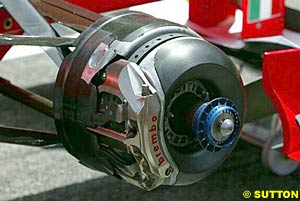 As mentioned, the cooling package required more outlet area for the complex radiator installation, and initially chimneys were installed with a small opening at the end of the coke bottle shape. This setup remains, although the coke bottle opening is now a little wider and has been matched by the optional outlets along to the top edge of the sidepods. By use of different panels, the team can add up to six slots to exhaust hot air from the top of the sidepods nearest to the oil coolers. In the race, Ferrari ran six slot gills on the right side and a closed outlet on the left.
As mentioned, the cooling package required more outlet area for the complex radiator installation, and initially chimneys were installed with a small opening at the end of the coke bottle shape. This setup remains, although the coke bottle opening is now a little wider and has been matched by the optional outlets along to the top edge of the sidepods. By use of different panels, the team can add up to six slots to exhaust hot air from the top of the sidepods nearest to the oil coolers. In the race, Ferrari ran six slot gills on the right side and a closed outlet on the left.
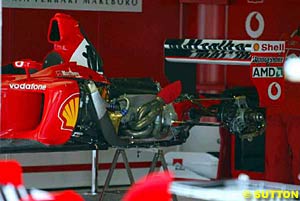 The other major visual change to the car are the bargeboards, which now feature a Sauber-like twin setup on the smaller outer board, which was added to direct the airflow around the undercut of the sidepod. On the larger inner bargeboard, a small strake has been added. This ties in with the height of the flip up along the edge of the sidepod, and probably tries to split the flow over and under the flip up.
The other major visual change to the car are the bargeboards, which now feature a Sauber-like twin setup on the smaller outer board, which was added to direct the airflow around the undercut of the sidepod. On the larger inner bargeboard, a small strake has been added. This ties in with the height of the flip up along the edge of the sidepod, and probably tries to split the flow over and under the flip up.
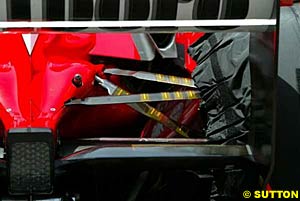 Despite a subtly revised rear suspension layout, the F2003-GA races with the longer rear torsion bars protruding through the bodywork. This allows a longer rear wheel travel to accommodate the kerbs.
Despite a subtly revised rear suspension layout, the F2003-GA races with the longer rear torsion bars protruding through the bodywork. This allows a longer rear wheel travel to accommodate the kerbs.
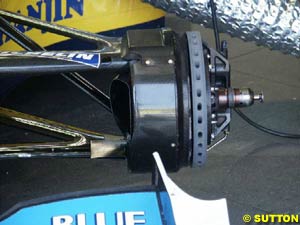 Renault carried over the new Imola front wing endplate and introduced new two-scoop brake ducts, the larger duct for the disc rotor being complimented by a lower McLaren-like duct to cool the calliper.
Renault carried over the new Imola front wing endplate and introduced new two-scoop brake ducts, the larger duct for the disc rotor being complimented by a lower McLaren-like duct to cool the calliper.
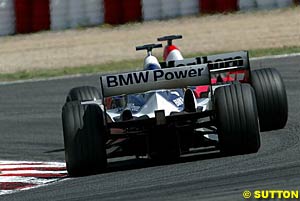 Williams appeared in Barcelona with the revised bodywork from Brazil along with the Imola diffuser - including a reworked floor on either side of the diffuser - as well as the torsion bar gearbox/suspension. Williams continued their propensity to have flexing aerodynamic surfaces with the sidepod winglets now appearing to droop down at speed. As Spain was quite a hot race, Williams ran an asymmetrical cooling setup with one small and one large chimney.
Williams appeared in Barcelona with the revised bodywork from Brazil along with the Imola diffuser - including a reworked floor on either side of the diffuser - as well as the torsion bar gearbox/suspension. Williams continued their propensity to have flexing aerodynamic surfaces with the sidepod winglets now appearing to droop down at speed. As Spain was quite a hot race, Williams ran an asymmetrical cooling setup with one small and one large chimney.
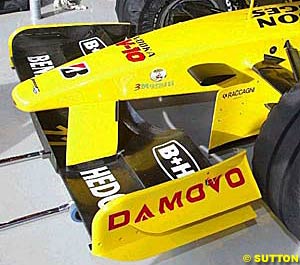 Development work to endow the EJ13 with more grip continued in Spain, with new front wing endplates now featuring a drooped flip up and no longer the clear horizontal strake. The Imola notched rear wing endplate was retained, and the gearbox now features an alloy casing fully wrapped in carbon fibre, rather than just the separate upper section.
Development work to endow the EJ13 with more grip continued in Spain, with new front wing endplates now featuring a drooped flip up and no longer the clear horizontal strake. The Imola notched rear wing endplate was retained, and the gearbox now features an alloy casing fully wrapped in carbon fibre, rather than just the separate upper section.
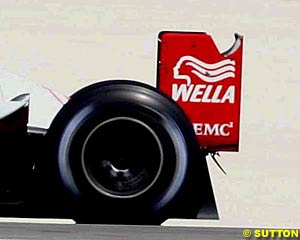 Without major new updates on the car - but carrying over Imola's notched rear wing endplate - Toyota had their best weekend of the year thus far, and both drivers were able to find a setup to suit them.
Without major new updates on the car - but carrying over Imola's notched rear wing endplate - Toyota had their best weekend of the year thus far, and both drivers were able to find a setup to suit them.
Please Contact Us for permission to republish this or any other material from Atlas F1.
|
Volume 9, Issue 19
Atlas F1 Special
View from the Paddock: Special Edition
Lost Weekend: Interview with Pizzonia
Renault to the Fore
Spanish Moss
Spanish GP Review
2003 Spanish GP Review
Technical Review: Spanish GP
Racers or Timeservers?
The Reign in Spain
Stats Center
Qualifying Differentials
SuperStats
Charts Center
Columns
Season Strokes
F1 FAQ
Elsewhere in Racing
The Weekly Grapevine
> Homepage |